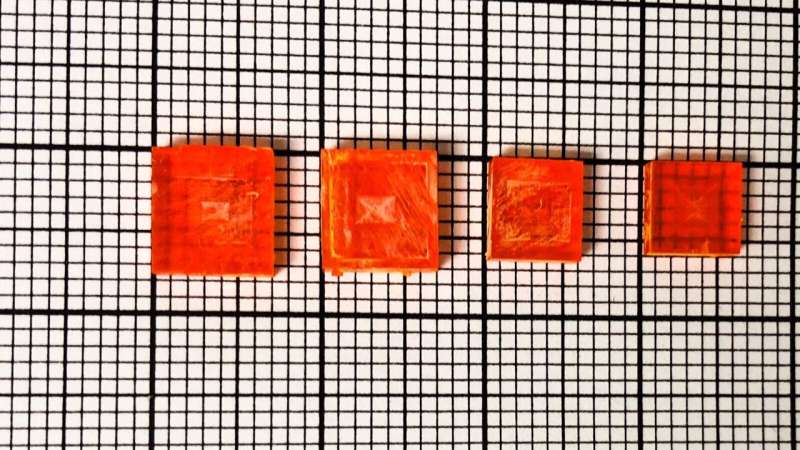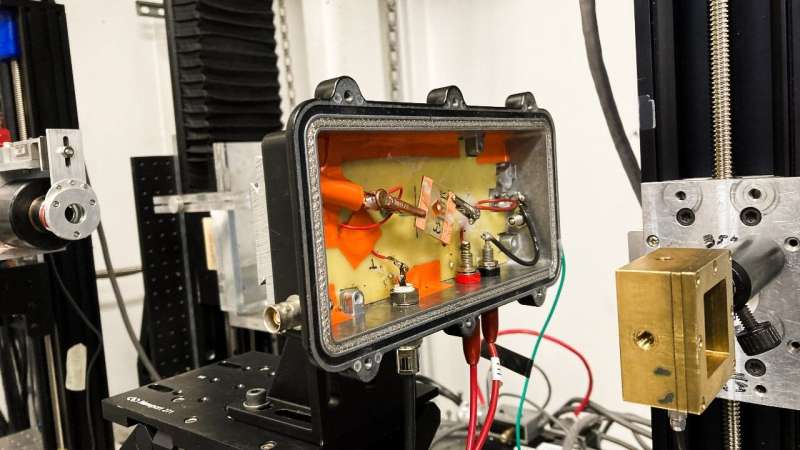This article has been reviewed according to Science X's editorial process and policies. Editors have highlighted the following attributes while ensuring the content's credibility:
fact-checked
peer-reviewed publication
trusted source
proofread
Scientists discover a durable but sensitive material for high energy X-ray detection

X-ray technology plays a vital role in medicine and scientific research, providing non-invasive medical imaging and insight into materials. Recent advancements in X-ray technology enable brighter, more intense beams and imaging of increasingly intricate systems in real-world conditions, like the insides of operating batteries.
To support these advancements, scientists are working to develop X-ray detector materials that can withstand bright, high-energy X-rays—especially those from large X-ray synchrotrons—while maintaining sensitivity and cost-effectiveness.
A team of scientists at the U.S. Department of Energy's (DOE) Argonne National Laboratory and their colleagues have demonstrated exceptional performance of a new material for detecting high energy X-ray scattering patterns. With excellent endurance under ultra-high X-ray flux and relatively low cost, the detector material may find wide application in synchrotron-based X-ray research.
During an X-ray scattering experiment, a beam of photons—or light particles—travels through a sample being studied. The sample scatters the photons, which then strike the detector material. Analyzing how the X-rays are scattered gives scientists a view of the sample's structure and makeup.
"Many of the current detector materials can't handle the wide range of beam energies and enormous X-ray fluxes coming out of large synchrotron facilities. The ones that can are often expensive or hard to grow, or they have to be cooled to very low temperatures," said Antonino Miceli, a physicist at Argonne's Advanced Photon Source (APS), a DOE Office of Science user facility.
Driven by the need for better detector materials, the team analyzed the performance of cesium bromide perovskite crystals. Perovskites have simple structures with highly tunable properties, making them suitable for a range of applications.
The material was grown using two different methods. One method involved melting and cooling the material to induce crystal formation, which was done in the laboratory of Duck Young Chung, a scientist in Argonne's Materials Science division. The other was a solution-based approach where the crystals are grown at room temperature. This work was performed at Northwestern University in the laboratory of Mercouri Kanatzidis, a senior scientist at Argonne with a joint appointment at Northwestern.
"At beamline 11-ID-B at the APS, we assessed crystals made using these two strategies and how they do under a wide range of synchrotron fluxes," said Kanatzidis. "The results were quite astonishing."
Grown using both methods, the material showcased exceptional detection capabilities and withstood fluxes up to the limit of the APS without any issues.

"This detector material can distinguish small changes, revealing greater insight into real materials in real conditions," said Miceli. "It's relatively dense compared to common detector materials like silicon, and it's structured in a way that influences its electrical properties for better efficiency and sensitivity."
High energy X-rays enable researchers to study dynamic systems in real time. These include biological processes in cells or chemical reactions inside an engine. With the new detector's ability to detect subtle changes during experiments, researchers can obtain valuable insight into intricate and rapid activity in materials, facilitating faster and more detailed studies.
Superior detector materials at the APS are even more crucial now that the facility is undergoing a major upgrade that will increase the brightness of its beamlines by up to 500 times.
"Our group was able to grow extremely high-quality crystals because of the unique set of capabilities and expertise at Argonne, which really helped improve the material's performance," said Chung.
Looking ahead, the research team aims to focus on scaling up production and optimizing crystal quality. They anticipate additional applications for the material, including its potential use in detecting gamma rays at extremely high energies with support from the DOE National Nuclear Security Administration.
The results of the experiments were reported in Advanced Materials and Advanced Optical Materials.
More information: Lei Pan et al, Ultrahigh‐Flux X‐ray Detection by a Solution‐Grown Perovskite CsPbBr3 Single‐Crystal Semiconductor Detector, Advanced Materials (2023). DOI: 10.1002/adma.202211840
Lei Pan et al, Perovskite CsPbBr3 Single‐Crystal Detector Operating at 1010 Photons s−1 mm−2 for Ultra‐High Flux X‐ray Detection, Advanced Optical Materials (2023). DOI: 10.1002/adom.202202946
Journal information: Advanced Optical Materials , Advanced Materials
Provided by Argonne National Laboratory




















